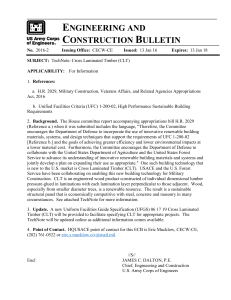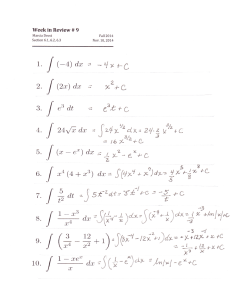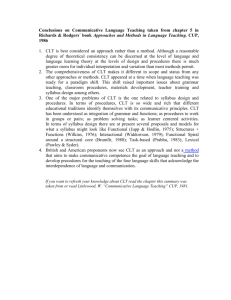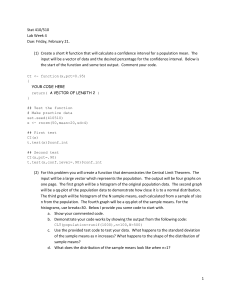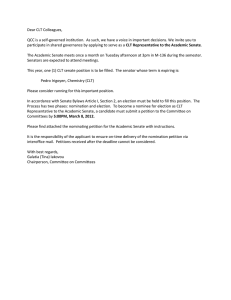C P E
advertisement
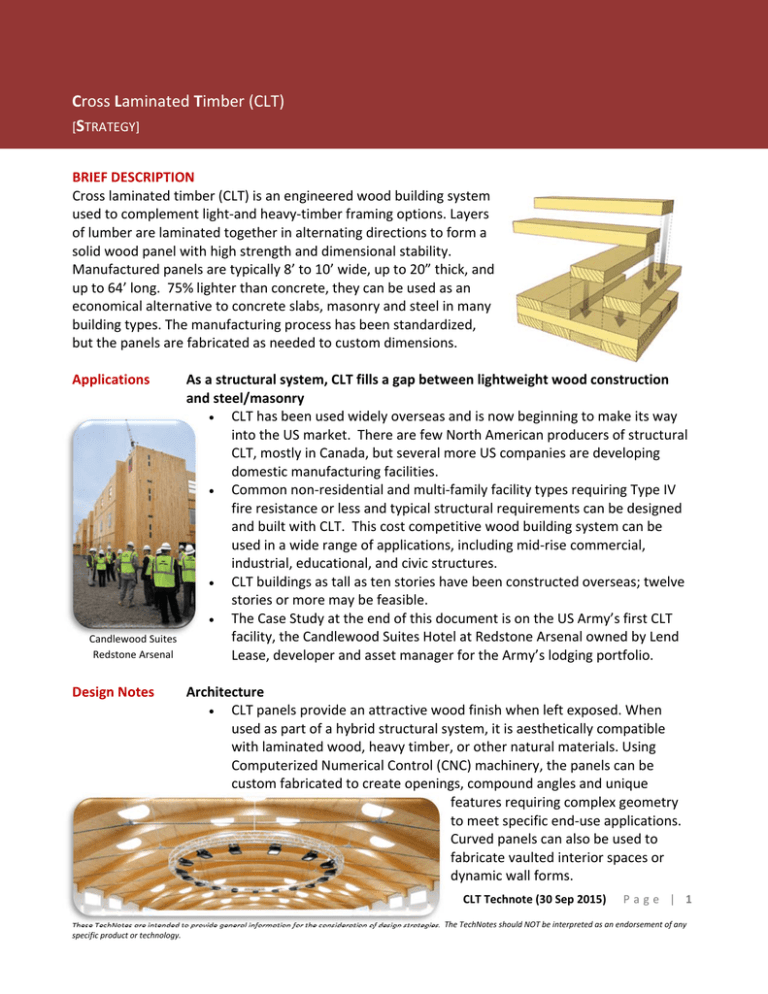
Cross Laminated Timber (CLT) Cross Laminated Timber (CLT) [S[TRATEGY] PRODUCT AND ECONOM BRIEF DESCRIPTION Cross laminated timber (CLT) is an engineered wood building system used to complement light‐and heavy‐timber framing options. Layers of lumber are laminated together in alternating directions to form a solid wood panel with high strength and dimensional stability. Manufactured panels are typically 8’ to 10’ wide, up to 20” thick, and up to 64’ long. 75% lighter than concrete, they can be used as an economical alternative to concrete slabs, masonry and steel in many building types. The manufacturing process has been standardized, but the panels are fabricated as needed to custom dimensions. Applications As a structural system, CLT fills a gap between lightweight wood construction and steel/masonry CLT has been used widely overseas and is now beginning to make its way into the US market. There are few North American producers of structural CLT, mostly in Canada, but several more US companies are developing domestic manufacturing facilities. Common non‐residential and multi‐family facility types requiring Type IV fire resistance or less and typical structural requirements can be designed and built with CLT. This cost competitive wood building system can be used in a wide range of applications, including mid‐rise commercial, industrial, educational, and civic structures. CLT buildings as tall as ten stories have been constructed overseas; twelve stories or more may be feasible. The Case Study at the end of this document is on the US Army’s first CLT facility, the Candlewood Suites Hotel at Redstone Arsenal owned by Lend Candlewood Suites Redstone Arsenal Lease, developer and asset manager for the Army’s lodging portfolio. Design Notes Architecture CLT panels provide an attractive wood finish when left exposed. When used as part of a hybrid structural system, it is aesthetically compatible with laminated wood, heavy timber, or other natural materials. Using Computerized Numerical Control (CNC) machinery, the panels can be custom fabricated to create openings, compound angles and unique features requiring complex geometry to meet specific end‐use applications. Curved panels can also be used to fabricate vaulted interior spaces or dynamic wall forms. CLT Technote (30 Sep 2015) P a g e | 1 These TechNotes are intended to provide general information for the consideration of design strategies. The TechNotes should NOT be interpreted as an endorsement of any specific product or technology. Cross Laminated Timber (CLT) Cross Laminated Timber (CLT) [S[P TRATEGY] ECONOM RODUCT AND CLT Testing Surface Charring Design Flexibility The thickness of a CLT panel can be increased to allow for longer spans requiring fewer interior support elements. Structural slabs can be manufactured up to 19” thick. Manufacturers use CNC equipment to cut panels and openings to exact specifications, often with tight tolerances. Seismic Performance and Blast Protection CLT offers good ductile behavior and energy dissipation. Because of their dimensional stability and rigidity, CLT panels create an effective lateral load resisting system. Researchers have conducted extensive seismic testing on CLT and found panels to perform exceptionally well with no residual deformation, particularly in multi‐story applications. In Japan, for example, a seven‐story CLT building was tested on the world’s largest shake table. It survived 14 seismic events with minimal damage. Dynamic “blast” testing was conducted in 2015, and the USACE Protective Design Center has been collaborating with industry and other government agencies to further document material properties to show that CLT structures meet Anti‐Terrorism/Force Protection (AT/FP) standards. Fire Protection Similar to Heavy Timber construction CLT’s thick cross‐section provides valuable fire resistance because panels char slowly. Once formed, a charred outer layer insulates and protects the wood core from further degradation. When used as Type IV construction, CLT assemblies also have fewer concealed spaces, which reduces a fire’s ability to spread between spaces undetected. If used for interior walls, CLT offers increased fire protection through greater compartmentalization as well. Acoustic Performance Test results show that because the mass of the wall contributes to acoustic performance, CLT building systems augment noise control for both airborne and impact sound transmission. The relatively tight construction CLT building systems offer also improves sound insulation at the interfaces between the floor and wall plates. Material Properties Since CLT panels resist high racking and compressive forces, they are particularly cost effective for multi‐story and long‐span diaphragm applications. They weigh less than concrete or steel, so can also reduce foundation costs. CLT panels act as two‐way slabs, the stronger direction follows the grain of the outer layers. For example, when CLT is used in floors or roofs, panels are installed so the boards on the outer layer run parallel to the span. CLT Technote (30 Sep 2015) P a g e | 2 These TechNotes are intended to provide general information for the consideration of design strategies. The TechNotes should NOT be interpreted as an endorsement of any specific product or technology. Cross Laminated Timber (CLT) Cross Laminated Timber (CLT) [E[NERGY AND PRODUCT AND ENVIRONMENT] ECONOM Environment Guiding Principles Sustainability Wood, unlike steel or concrete, is a renewable resource. Mostly rapidly renewable small‐diameter timber is used as well. Although not yet available in the US market, CLT panels may be certified as sustainable and qualify for LEEDtm points if they are fabricated from Forest Stewardship Council (FSC) approved wood sources and the proper Chain of Custody (CoC) documentation maintained. Indoor Air Quality The majority of these products are manufactured with formaldehyde‐ free adhesives, so off‐gassing of Volatile Organic Compounds (VOCs) is negligible. Waste Stream Since CLT panels are custom manufactured to their final dimensions, construction waste is minimized as well. CLT panels may be deconstructed and reused or repurposed intact. Most manufacturers use adhesives that allow CLT panels to be converted to Biofuel pellets when no longer needed at the end of their life cycle. In Canada, CLT has successfully made use of dead wood killed by Mountain Pine Beetle infestations. (However, since these beetles primarily attack trees over 80 years old, they are not certifiable by FSC, which prohibits harvesting from old‐growth forests.) Mountain Pine Beetle Carbon Sequestration Made of all wood, CLT panels are a carbon sink. A carbon sink is a reservoir for carbon, meaning that it “sequesters” carbon in solid form and keeps it from entering the atmosphere as CO2. CLT stores more carbon than many alternative non‐wood building materials. When this is factored into an environmental life cycle analysis, CLT may prove to have a negative carbon footprint. Optimize Energy Performance (Energy Efficiency) Thermal performance of a building envelope is largely determined by the composite resistance to heat flow of its component materials per inch. Wood has more resistance to heat flow per inch than concrete, masonry, or steel. Thus, thicker panels are better insulators and require less insulation to be externally applied. Since CLT panels are typically manufactured using CNC equipment to precise tolerances, panel joints fit tightly. Because the panels are solid, CLT Technote (30 Sep 2015) P a g e | 3 These TechNotes are intended to provide general information for the consideration of design strategies. The TechNotes should NOT be interpreted as an endorsement of any specific product or technology. Cross Laminated Timber (CLT) Cross Laminated Timber (CLT) PRODUCT AND ECONOM [E[NERGY AND ENVIRONMENT] there is little potential for airflow through them as well. These factors are conducive to a tight envelope, limiting infiltration energy losses. Enhance Indoor Environmental Quality The majority of these products are manufactured with formaldehyde‐ free adhesives, so off‐gassing of Volatile Organic Compounds (VOCs) is negligible. Green/LEED Certification Credits Materials and Resources (MR) Credit 2: Construction Waste Management Highly pre‐fabricated CLT panels avoid construction waste, indirectly making MR Credit 2 easier to achieve. MR Credit 3, Materials Reuse Buildings made from CLT panels can be deconstructed and the panels easily reused. MR Credit 5, Regional Materials If the CLT panels were produced locally using locally‐sourced wood, it could be considered a “regional material”. However, at this time CLT is not yet readily available in the U.S. in many areas, but it likely will be in the near future given its variety of benefits. MR Credit 7, Certified Wood Certification of CLT products is dependent upon the certification of the underlying wood. The only wood that the LEED program considers to be "Certified Wood" under the current rules is wood certified by the Forest Stewardship Council (FSC). FSC Certified wood must carry a Chain of Custody (CoC) certificate with it as it makes its way from harvesting through fabrication and distribution to wherever it ends up. Most of the CLT products available in North America come from Canadian forests which are not typically FSC certified, but market availability of Cross Laminated Timber made from certified wood is expected to grow. . Since the aforementioned Mountain Pine Beetle primarily attacks and kills mature trees over 80 years old, CLT panel manufacturers that make use of an abundance of beetle‐kill wood will not likely be certified by the FSC, which prohibits harvesting old‐growth forests. Energy and Atmosphere (EA) Credit 1, Optimize Energy Performance Since insulative CLT panels help maintain indoor temperatures and humidity (if left bare) they could help a building optimize its energy performance. See discussion points under Guiding Principles above. CLT Technote (30 Sep 2015) P a g e | 4 These TechNotes are intended to provide general information for the consideration of design strategies. The TechNotes should NOT be interpreted as an endorsement of any specific product or technology. Cross Laminated Timber (CLT) Cross Laminated Timber (CLT) [P[P RODUCT AND RODUCT AND EECONOMICS] CONOM Product Images Section A‐A Section B‐B (Source: CLT Handbook) Components Relative Cost (Source: CLT Handbook) (Source: CLT Handbook) CLT panels are fabricated from layers of lumber laminated crosswise (typically at 90 degrees). Besides gluing, nails or wooden dowels can also be used to attach the layers. Panels are normally manufactured with an odd number of layers resulting in a primary strength axis in the direction of the boards in the outermost layers. Three to seven layers are most common, but more may be used in some cases. In special circumstances, consecutive layers may be placed in the same direction, giving a double layer (e.g., double longitudinal layers at the outer faces and/or additional double layers at the core of the panel) to meet specific structural requirements. The thickness of lumber selected for a panel may vary from 5/8” to 2” while the widths may vary from about 2.4 to 9.5 inches. Boards are finger jointed end‐to‐end using structural adhesive. Lumber is visually graded or machine stress rated and kiln dried. Typical widths are 2’, 4’, 8’ and 10’ while lengths can be up to 60’ or more. Thicknesses can be up to 20 inches. Transportation restrictions may impose limitations to CLT panel sizes that can be used. Openings and chases can be pre‐cut into the panels. In general, CLT is more expensive than “stick‐built” light wood frame construction, but less than non‐wood for low‐rise facilities and up. Tech1 Light Wood Frame CLT Non‐ Wood2 Total Components Building Shell Foundation Speed (“Time=$”) Building Shell Foundation Speed (“Time=$”) Building Shell Foundation Speed (“Time=$”) Best Value 3 floors $17/sf Light Medium $30/sf Light Fast $23/sf Medium Slow Lt.Wd or Block 5 floors $17/sf Light Medium $31/sf Light Fast $32/sf Heavy Slow Lt.Wd or CLT 8 Floors $30/sf Med Fast $34/sf Heavy Slow CLT 1 – Source: CLT Handbook; 2‐ Non‐Wood includes block masonry, concrete, and steel CLT Technote (30 Sep 2015) P a g e | 5 These TechNotes are intended to provide general information for the consideration of design strategies. The TechNotes should NOT be interpreted as an endorsement of any specific product or technology. Cross Laminated Timber (CLT) Cross Laminated Timber (CLT) Cross Laminated Timber (CLT) [[PPRODUCT AND EECONOMICS] [RODUCT AND PRODUCT AND CONOMICS] ECONOM Product Types ANSI/APA PRG 320 Standard for Performance‐Rated Cross Laminated Timber is a reference standard to assist in the design and specification of CLT products. CLT Stress classes (Non‐mandatory; other stress grades are permitted) o See Table A1 in ANSI/APA PRG 320 Annex A for allowable design properties in the US for the above Stress Grades. As non‐ mandatory, desired Stress Class must be specified. CLT Appearance Classification, Appendix A o A1. Architectural Appearance Classification ‐ An appearance classification normally suitable for applications where appearance is an important but not overriding consideration. o A2. Industrial Appearance Classification ‐ An appearance classification normally suitable for use in concealed applications where appearance is not of primary concern. o Appearance Classifications are non‐mandatory and not required to comply with the standard. Desired appearance classification must be specified. Vendors Nordic X‐Lam, Nordic Engineered Wood Montreal, Quebec, Canada http://www.nordicewp.com CrossLam, Structurlam Products LP Penticton, British Columbia, Canada http://www.structurlam.com Riddle Laminators, DR Johnson Lumber Riddle, Oregon, USA http://www.drjlumber.com/ ≡MORE ON THE WAY… Warranty Info Generally not applicable to CLT panels Code Status See Specifications section for recent code acceptance CLT Technote (30 Sep 2015) P a g e | 6 These TechNotes are intended to provide general information for the consideration of design strategies. The TechNotes should NOT be interpreted as an endorsement of any specific product or technology. Cross Laminated Timber (CLT) Cross Laminated Timber (CLT) [S[PECIFICATIONS] PRODUCT AND ECONOM Getting Started Everything You Need to Know to Start Using CLT: The U.S. Edition of the CLT Handbook: Cross‐Laminated Timber can be downloaded without charge from http://www.masstimber.com. Hard copies of the CLT Handbook as well as the 2015 National Design Specification (NDS) can be acquired through American Wood Council (AWC) at http://www.awc.org. Guide Specs A Uniform Facilities Guide Specification (UFGS) will be developed. Until then, projects will need to develop their own specifications referencing the other technical documents herein. Code Acceptance The code language for CLT construction has been integrated into the 2015 International Building Code (IBC) and associated provisions referenced in the 2015 National Design Specification (NDS). ANSI/APA PRG 320 “Standard for Performance‐Rated Cross Laminated Timber” provides a solid reference for standards. Specific paragraphs of note in the 2‐15 IBC: Type IV Construction – Exterior Walls 2303.1.4 Structural glued cross laminated timber. Cross‐laminated timber shall be manufactured and identified as required in ANSI/APA PRG 320‐2011. 602.4.2 Cross‐laminated timber complying with Section 2303.1.4 [above] shall be permitted within exterior wall assemblies with a 2‐hour rating or less provided: o Exterior surface of the cross‐laminated timber is protected fire retardant treated wood sheathing complying with 2303.2 and not less than 15/32 inch thick; OR o Gypsum board not less than ½ inch thick; OR o A noncombustible material. Type IV Construction – Floors 602.4.6.2 CLT. Cross‐laminated timber shall not be less than 4 inches (102mm) in thickness. It shall be continuous from support to support and mechanically fastened to one another. Cross laminated timber shall be permitted to be connected to walls without a shrinkage gap providing swelling or shrinking is considered in the design…. Type IV Construction – Roofs 602.4.7 Roofs. Roofs shall be without concealed spaces and wood roof decks shall be sawn or glue laminated…or of cross laminated timber… Cross laminated timber roofs shall not be less than 3 inch nominal in thickness and shall be continuous from support to support and mechanically fastened to one another. CLT Technote (30 Sep 2015) P a g e | 7 These TechNotes are intended to provide general information for the consideration of design strategies. The TechNotes should NOT be interpreted as an endorsement of any specific product or technology. Cross Laminated Timber (CLT) Cross Laminated Timber (CLT) [S[PECIFICATIONS] PRODUCT AND ECONOM In summary, 2015 IBC allows CLT for most occupancies of Type VB and IV construction, and possibly as a part of VA IIIA and IIIB construction. Seismic Design The American Society of Civil Engineers (ASCE) publication ASCE 7‐10 is a primary document used to develop the wind and seismic loading for structures. Chapter 12 establishes the seismic design coefficients which have not been established at this time for CLT, but the effort to develop these criteria is near the end of testing. Until then, the State of Oregon adopted the parameters below for CLT construction as conservative values which can be used until the final results are published. Cross‐laminated timber structures are a bearing wall system and can be used with Table 12.2‐1 (A – Bearing Wall Systems) of ASCE 7‐ 10 for seismic calculations with an added row for “Cross‐laminated timber shear wallsl ” as a Seismic Force‐Resisting System using the following values: ASCE 7 Section Where Detailing Requirements Are Specified: 14.1 & 14.5 Response Modification Coefficient, Ra: 2 Overstrength Factor, Ω0g: 2‐1/2 Deflection Amplification Factor, Cdb: 2 Structural System Limitations Including Structural Height, hn (ft) Limitsc: o Seismic Design Category B, C, Dd, Ed, Fe: NL See ASCE 7‐10 for further information and table footnotes for Table 12.2‐1. Performance‐based procedures in ASCE 7‐10 is also a viable alternative. Force Protection The USACE Protective Design Center (PDC) has been colaborating on research and testing to calculate Single Degree of Freedom (SDOF) properties used in modeling for blast protection. A report2 issued 4 August 2015 recommended that SDOF properties can be calculated from the manufacturer data using a 0.70 factor applied to the stiffness for the panels and using a strength increase factor of 1.6 applied to the recommended design stress in calculating resistance. Using the above factors and typical equations to calculate the SDOF properties, a model can provide reasonable predictions of response for CLT panels to be used in design. These results were obtained for simply supported panels, but they are equally appropriate for panels with fixed‐fixed supports that undergo moment reversal across the span. In the tests, the panels were evaluated up to fracture response without inducing a catastrophic failure. However, the static tests indicate a sharp drop in resistance after initial cracking. Therefore, a reasonable ductility limit for design purposes can be selected near but below a ductility of 1.0. A conservative value such as 0.8 would be prudent. This ductility would correspond to an MLOP, while a 1.0 may be used for a LLOP. _____________________ 1 Derived from Oregon Statewide Alternative Method No. 15‐01 Cross‐Laminated Timber Provisions (Ref.: ORS 455.060) 2 From Static and Dynamic Testing of Cross Laminated Timber Panels, Final Report, dated 4 Aug 2015 by BakerRisk #01‐05261‐001‐15 CLT Technote (30 Sep 2015) P a g e | 8 These TechNotes are intended to provide general information for the consideration of design strategies. The TechNotes should NOT be interpreted as an endorsement of any specific product or technology. Cross Laminated Timber (CLT) Cross Laminated Timber (CLT) [C[ASE PRODUCT AND STUDY] ECONOM Candlewood Suites Hotel Redstone Arsenal, Alabama Site Location Facility Approach Results 4‐story, 58,000sf hospitality facility Owned by Lend Lease, developer & asset manager for Army lodging. First full CLT hotel in US First to meet resistance to progressive collapse design standards and AT/FP blast resistance standards 27% Est. Energy Reduction 1640 tons of Stored Carbon Met Army LEEDtm Design Goals FAST&SAFE ⪧ Perimetersafetyrailing installedonslabbefore hoisting ⪧ Exteriorwallsserveas protection ⪧ Permanentstairs installedearly ⪧ Noneedfornets CLT Technote (30 Sep 2015) P a g e | 9 These TechNotes are intended to provide general information for the consideration of design strategies. The TechNotes should NOT be interpreted as an endorsement of any specific product or technology.
